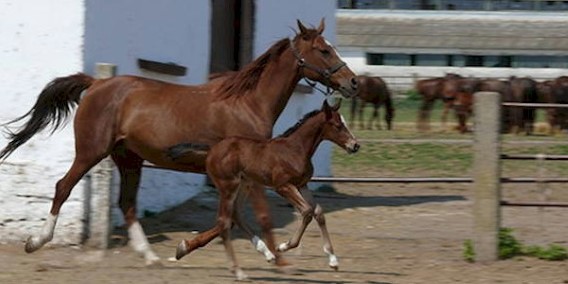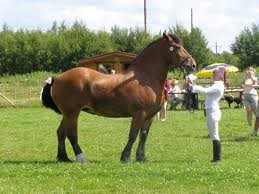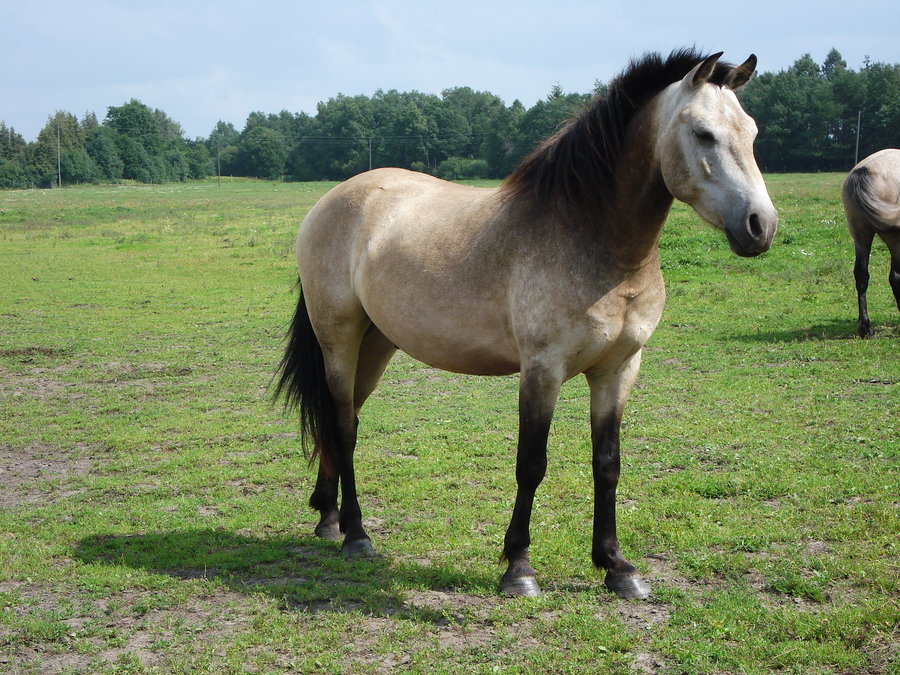 East Bulgarian
East Bulgarian
 East Bulgarian horses are an elegantly-built light horse
that developed over the last 100 years. They are used mainly for under saddle
and light draft work, and are well-suited for a variety of competitive sports,
ranging from dressage to eventing.
East Bulgarian horses are an elegantly-built light horse
that developed over the last 100 years. They are used mainly for under saddle
and light draft work, and are well-suited for a variety of competitive sports,
ranging from dressage to eventing.
They began develop at the end of the 19th century at the "Kabiuk" stud farm (former Vassil Kolarov) near Shumen and at stud farm in Bozhurishte near Sofia, in Bulgaria, by crossing local horses with Arabians, Anglo-Arabians, Thoroughbreds, and English half-breds. Once established, only additional Thoroughbred blood was added to improve their quality. They were officially recognized as a breed in 1951.
They generally stand 15 to 16 hands high, and are u ...

 Einsiedler
Einsiedler
 Einsiedler (also known as Swiss Anglo Norman or the Swiss
Half Bred) are blooded horses horses from Switzerland. They have been in
circulation since the tenth century. They were developed at the Benedictine
Abbey of Einsiedeln with Schwyer Horses, a local stock establishment. Around
the middle of the sixteenth century, they founded their very own studbook. They
became so popular that by the middle of the seventieth century a new studbook
was in rotation created by Father Isidor Moser. They were recreated by
utilizing mares of Anglo Norman decent and ones of Holstein roots to formulate
a breed referred to as Bracken horses. Some breeders continued their efforts of
crossing the blood lines and went on experimenting with Swedish lines
...
Einsiedler (also known as Swiss Anglo Norman or the Swiss
Half Bred) are blooded horses horses from Switzerland. They have been in
circulation since the tenth century. They were developed at the Benedictine
Abbey of Einsiedeln with Schwyer Horses, a local stock establishment. Around
the middle of the sixteenth century, they founded their very own studbook. They
became so popular that by the middle of the seventieth century a new studbook
was in rotation created by Father Isidor Moser. They were recreated by
utilizing mares of Anglo Norman decent and ones of Holstein roots to formulate
a breed referred to as Bracken horses. Some breeders continued their efforts of
crossing the blood lines and went on experimenting with Swedish lines
...

 Eriskay
Eriskay
 Eriskay ponies originated from the Outer Hebrides (an island chain off the west coast of mainland
Scotland). They are considered a very pleasing type of horse and also
quite strong. They can be used for harness work, riding, and are the ideal
breed for little ones to learn how to ride. They can be found in Scotland,
Ireland, United Kingdom, Wales, and the northern parts of France.
Eriskay ponies originated from the Outer Hebrides (an island chain off the west coast of mainland
Scotland). They are considered a very pleasing type of horse and also
quite strong. They can be used for harness work, riding, and are the ideal
breed for little ones to learn how to ride. They can be found in Scotland,
Ireland, United Kingdom, Wales, and the northern parts of France.
The locals, the Pict community of people, were very eager to raise and breed this animal. They have received their unique name from where they are from, the Eric’s Isle or otherwise known as the Eriskay area located in Scotland. It''s very common to see Eriskay horses grazing there. The crofters was just one group that was very fond of this ...

 Esperia Pony
Esperia Pony
 Nestled in the Monti Ausoni and Monti Aurunci mountains of Italy''s Lazio region, the Esperia pony is a symbol of both historical ingenuity and remarkable resilience. Originally named for Baron Ambrogio Roselli di Esperia who selectively bred them, these ponies once carried light loads and provided meat for local communities.
Nestled in the Monti Ausoni and Monti Aurunci mountains of Italy''s Lazio region, the Esperia pony is a symbol of both historical ingenuity and remarkable resilience. Originally named for Baron Ambrogio Roselli di Esperia who selectively bred them, these ponies once carried light loads and provided meat for local communities.
Only recognized as a distinct breed in 1962 and officially registered in 1992, the Esperia pony showcases its wild lineage through its hardy nature. They can thrive on meager land, withstand dry and barren conditions, and even go without water for extended periods.
Once tamed, however, their temperament transforms. These ponies become calm and even-tempered companions, suitable for both adults and ...

 Estonian
Estonian
 Estonian horses (also known as Estonian native, Estonian
Klepper, or natively Eesti hobune) are a relatively small horse. The Estonian
horse has influenced several Baltic horse breeds, including Tori horses. They
are strong and are resistant against sickness.
Estonian horses (also known as Estonian native, Estonian
Klepper, or natively Eesti hobune) are a relatively small horse. The Estonian
horse has influenced several Baltic horse breeds, including Tori horses. They
are strong and are resistant against sickness. Estonian Horses are descended from the primitive forest horses that lived in Northern Europe more than 5,000 years ago, and are considered the progenitor of other breeds such as the North Swedish Horse and the Dole Gudbrandsdal. They have retained its qualities and looks due to little influence by other horse breeds. However, it is believed that they became mixed with the now extinct Oland Horse, as large numbers of Oland Horses were exported to Estonia at one poin ...

 Estonian
Estonian
 Estonian horses (also known as Estonian native, Estonian
Klepper, or natively Eesti hobune) are a relatively small horse. The Estonian
horse has influenced several Baltic horse breeds, including Tori horses. They
are strong and are resistant against sickness.
Estonian horses (also known as Estonian native, Estonian
Klepper, or natively Eesti hobune) are a relatively small horse. The Estonian
horse has influenced several Baltic horse breeds, including Tori horses. They
are strong and are resistant against sickness. Estonian Horses are descended from the primitive forest horses that lived in Northern Europe more than 5,000 years ago, and are considered the progenitor of other breeds such as the North Swedish Horse and the Dole Gudbrandsdal. They have retained its qualities and looks due to little influence by other horse breeds. However, it is believed that they became mixed with the now extinct Oland Horse, as large numbers of Oland Horses were exported to Estonia at one poin ...

 Exmoor
Exmoor
 Exmoor ponies are an English breed that has many practical
uses. They are described as hardy, tough, and rather pleasant. They can be used
for riding, in competitions, and also in races. They are found in Scotland,
Ireland, Wales, France, and the United Kingdom (especially in the Exeter region).
They are considered very sweet and agile.
Exmoor ponies are an English breed that has many practical
uses. They are described as hardy, tough, and rather pleasant. They can be used
for riding, in competitions, and also in races. They are found in Scotland,
Ireland, Wales, France, and the United Kingdom (especially in the Exeter region).
They are considered very sweet and agile. Exmoor ponies are around twelve hands tall and are bred in brown shades. They have a smaller head considering their size and also have tough ribs. They are short creatures with strong feet. Compact and sturdy for their many useful purposes, they are neat and possess a unique muzzle.
